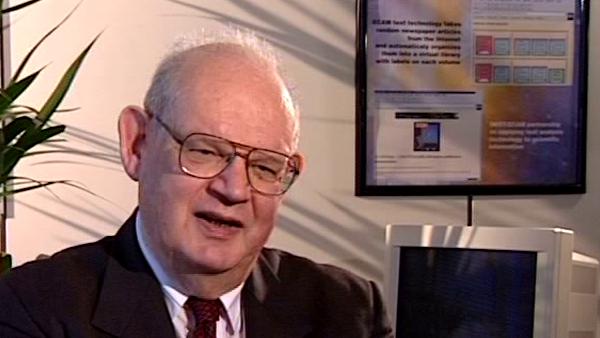I could develop it further, but let me immediately say how this work was received, because it is a very interesting phenomenon, which I would like to sketch. First of all, I became extremely widely known, very, very well known in the profession. I was asked to give lectures in every possible place; I was in the place of honour in many meetings; and the fact that something real of the complexity of price variation could be tamed became the subject of very great enthusiasm. Then, after several years, a reaction set in that lasted for quite a number of years. It was based first of all on observation by a very brilliant student at University of Chicago, Mr. Officer- Dr. Officer, who compared, who tested price changes that were not mine, not my cotton prices but other price changes, for this character of stability, which means a fixed point in the physics sense, which means scaling, another word used in physics. You take the price changes over days, months and years; if you properly scale them then the distribution of price changes should overlap completely and be identical. This was the case for the cotton prices; this was not the case for some other prices they examined. They observed that for short periods of time there was a great inequality, with long tails; it took longer periods of time - weeks and longer periods. The tails were rather shorter, as would be the case if after all the prices were tending towards the Gaussian. That is the sharp difference between price distribution for the Gaussian and the daily price changes were becoming less sharp as you took longer time intervals. That observation led people to believe that if you take longer periods then the Gaussian is going to be found again, and therefore the extraordinary complications that my work entailed did not have to be faced. Simultaneously some very brilliant people, Black, Scholes and Merton, showed that if prices had been indeed Gaussian, which nobody said was exact, but which was, they felt, not quite as bad as first believed, then one could make very specific evaluation of options. One could evaluate the price of very complicated combinations of prices, what came to be known as financial derivatives. Therefore, under conditions of a Gaussian universe, under conditions of a Bachelier model, which was again in 1900 the first and basic model of price variation, a great deal of control could be obtained. My work, on the contrary, was emphasising a level of non-controllability, which first of all was in a certain sense, negative, pessimistic, disappointing, because one wants to control as much as possible; and on the second hand, again, perhaps not necessary for some of these prices. Well, my feeling in the mid '60s was that the reaction of the community to my work had gone very much from enthusiasm, with one very brilliant and very effective student who became a very strong interpreter of theory, to a period of great caution, in fact of refusal; that in a way the profession was not ready to accept my verdict that the idea of inequality, which was the staple of everything in economics, like incomes, firm sizes, city sizes, etc., etc., was also a staple of price variation. But price variation was something simpler and I left this field completely for a very long time.
Benoît Mandelbrot (1924-2010) discovered his ability to think about mathematics in images while working with the French Resistance during the Second World War, and is famous for his work on fractal geometry - the maths of the shapes found in nature.
Title: Reaction to work in price change
Listeners:
Bernard Sapoval
Daniel Zajdenweber
Bernard Sapoval is Research Director at C.N.R.S. Since 1983 his work has focused on the physics of fractals and irregular systems and structures and properties in general. The main themes are the fractal structure of diffusion fronts, the concept of percolation in a gradient, random walks in a probability gradient as a method to calculate the threshold of percolation in two dimensions, the concept of intercalation and invasion noise, observed, for example, in the absorbance of a liquid in a porous substance, prediction of the fractal dimension of certain corrosion figures, the possibility of increasing sharpness in fuzzy images by a numerical analysis using the concept of percolation in a gradient, calculation of the way a fractal model will respond to external stimulus and the correspondence between the electrochemical response of an irregular electrode and the absorbance of a membrane of the same geometry.
Daniel Zajdenweber is a Professor at the College of Economics, University of Paris.
Duration:
4 minutes, 37 seconds
Date story recorded:
May 1998
Date story went live:
29 September 2010






